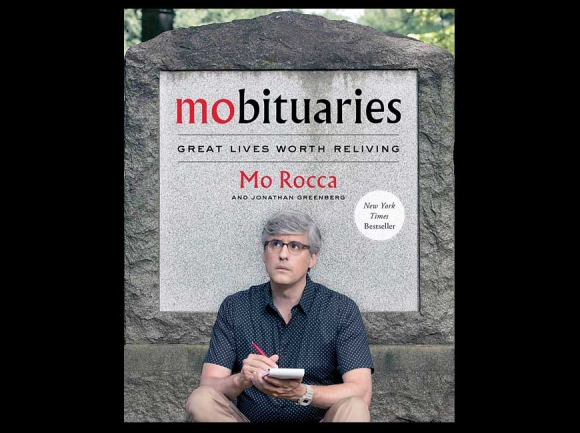Time for some fun. Time to pick up a copy of Mobituaries: Great Lives Worth Reliving (Simon & Schuster, 2019, 375 pages).
Here Mo Rocca along with Jonathan Greenberg take readers on a romp through history and culture that both educates us and brings some much needed wintertime entertainment and laughter. In this collection we meet deceased presidents, sports figures, actors and artists, politicians and charlatans — sometimes one and the same — pilots, pioneers in a dozen fields of science, and eccentrics of all sorts. We learn what happened to Galileo’s middle finger and Louis XIV’s heart (it was bought by a painter and ground into a shade called Mummy Brown); we discover Mrs. Winslow’s Soothing Syrup, a concoction used for teething babies and for adult ailments, later found to contain alcohol and morphine; we find a touching tribute to Billy Carter, brother of President Jimmy Carter and famous for his antics in the 1970s.
Mobituaries is definitely a “dipper” book, meaning you can pick it up and dip into it wherever you want to begin: the first pages, the middle or the end. That alone is part of the pleasure. One day you read the chapter titled “Died The Same Day: Farrah Fawcett (1947-2009) and Michael Jackson (1958-2009), pages 272-281. The next day you flip over to pages 316-331 and immerse yourself in “Death Of A Tree: The Live Oaks Of Toomer’s Corner (1937-2013).
Rocca’s depictions of personalities from the past sparkle with plenty of wit. In “Death Of A Country: Prussia (1525-1947), for example, Rocca tells us “I know the capital of every country in the world. I can freestyle-draw a map of the United States.” He then confesses he didn’t know where or exactly what Prussia was. He does his research, and in giving us a brief history of Prussia, he also brings a smile. Here he writes that “… in 1871, Bismarck united Prussia with other German-speaking states to form the German Empire. (Now’s when you start to hear the scary music playing in the background.) At this point Wilhelm assumed the title of Kaiser. (‘Kaiser’ is another name for emperor or hard roll.)”
Related Items
Though many of these figures are household names — the presidents, some actors, certain sports figures — many others were completely unfamiliar to me. Moses Fleetwood Walker (1857-1924) was a black baseball player who briefly participated in the major league of his time over 60 years before Jackie Robinson broke the color barrier; Giacomo Meyerbeer (1791-1864) ruled the opera world during the 1830s and 1840s before he fell victim to the anti-Semitism of Richard Wagner; the Washingtonian Movement (1840-1860) was an early version of Alcoholics Anonymous; Bessie Coleman (1892-1926) was the first black woman and first Native American to hold a pilot’s license; mathematician and Lord Byron’s daughter, Ada Lovelace (1815-1852), was one of the first to conceive that “a machine that could manipulate symbols in accordance with rules and that numbers could represent entities other than quantity marks the fundamental transition from calculation to computation,” meaning she contributed to the development of the computer.
At the heart of this compendium of the dead, some remembered, some largely forgotten, are several touching, longer descriptions.
In “Death Of An Icon: Audrey Hepburn (1929-1993),” Rocca takes us through Hepburn’s life: her sufferings in Holland during World War II, which according to her two sons had a “lifelong impact;” her climb to stardom, briefly covered; her popularity in Japan, where in the 1950s many girls cut their long hair to look like Hepburn. Those of us who have long admired Audrey Hepburn for her grace, her acting skills, and her humanitarian work can surely agree with Rocca when he concludes:
“On days when the news is particularly dreary, and people are being especially awful, and I’m flipping through the channels and I land on an Audrey Hepburn movie, I can’t help but wonder: ‘How did we drift so far from Audrey Hepburn? Can we ever get back?’ One can only hope so.”
Another entertainer who receives a glowing eulogy here is Sammy Davis Jr. (1925-1990). Some readers will remember this entertainer — part black, part Cuban, Jewish, one-eyed (he lost his left eye in a car accident at age 28), a member of the famous Rat Pack which included such luminaries as Frank Sinatra and Dean Martin — who could sing and dance with the best of them, and whose joy in performance shone like the sun. He made terrible choices in love, and according to one friend “was one of the worst people I ever saw with any kind of money,” but Davis was also, as Rocca writes, “a supernova talent.” At one point, Rocca raises a great point: “How is Sammy’s life not an Oscar-winning biopic …?” Here is a story that could indeed, in the right hands, become a major motion picture.
Beat the blues of old man winter and pick up a copy of Mobituaries.
(Jeff Minick is a writer and teacher. This email address is being protected from spambots. You need JavaScript enabled to view it.)




